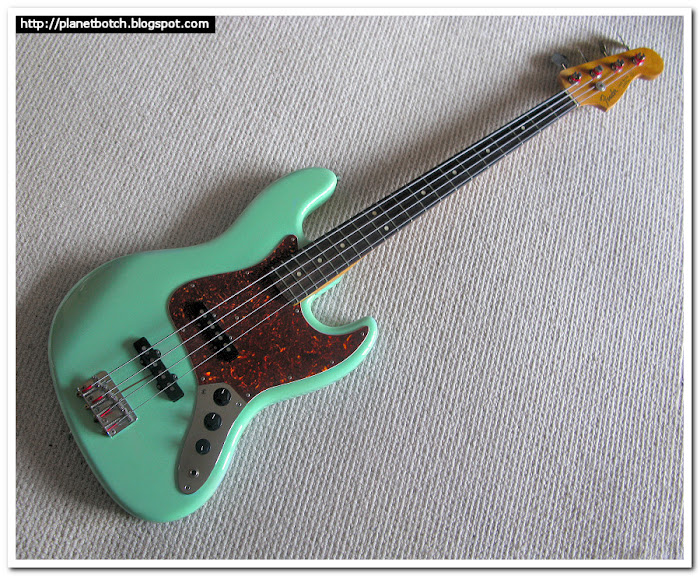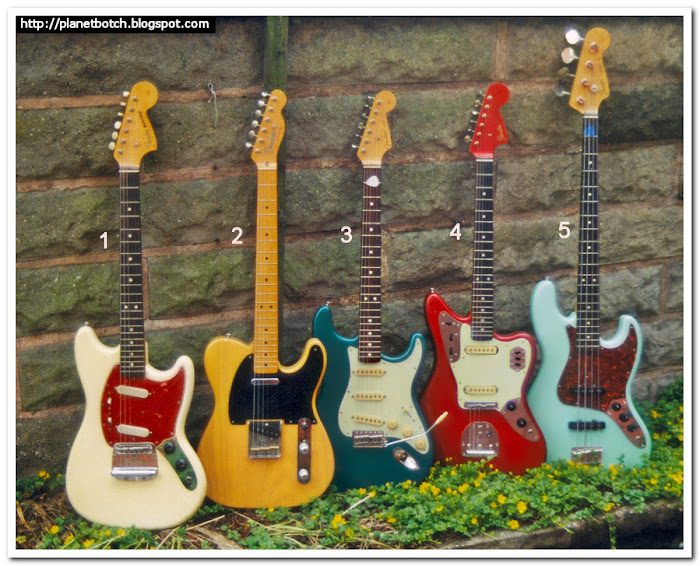The original Jazz Bass was introduced at the end of 1960 as a dual pickup stablemate for the Fender Precision. The Jazz differed from the Precision image-wise, in that it featured the then trendy offset contouring on the body. This aligned the new bass with the look of the range-topping Jazzmaster guitar. The Jazz’s neck was noticeably narrower than the Precision’s at the nut, but a similar width at the body end, and this gave it a pronounced taper when viewed from the front.

So, what makes this reissue a ’62, exactly? Well, the first version of the Jazz, in production for about a year, had string dampers, and what are well known as ‘stack knobs’. ‘Stack knobs’ were two-in-one volume/tone controls with an inner and an outer section working independently of each other. There were two ‘stack knobs’ on early Jazz Basses – one for each pickup – and no other switches or controls. But from the end of 1961 the control system was revised to comprise three conventional pots: a volume control for each pickup, and a universal tone control. The string damping system was also dropped. It’s at this point in time that the MIJ reissue fits in.
But by late 1962, Fender had brought in a different type of rosewood fingerboard. The flat-bottomed, chunky slab of rosewood (known as the ‘slab board’), as fitted to this reissue, was replaced with a kind of thick rosewood veneer with an arched bottom. Also, Fender had begun to place patent numbers beneath the manufacturer’s logo on the headstock. So a ’63 Jazz Bass would differ from the incarnation we see here. The period viability for these replicas is often very narrow. Through the mid ‘60s there were big changes to the Jazz’s neck, starting with a switch from whitish ‘clay’ dot position markers to pearloid dots, then the addition of fingerboard binding, and then the dropping of dot markers altogether to accommodate the more upmarket (but not necessarily more popular) pearloid blocks. By the end of the 1960s the Fender Jazz looked very significantly different from this version.
The colour of this reissue is, or at least was, sonic blue. But as I mentioned when I briefly alluded to this bass in another piece on the site, over the years the colour has changed. Sonic blue is a light blue – slightly more turquoise than sky blue, but it’s definitely blue. Check out the same bass on the right in the photo below and you’ll see something close to its original shade (you can see details about the guitars in that shot HERE).

However, the colour has now almost crossed the line into green territory. It’s clearly a progressive yellowing of the top coat, and in fact on the rear of the body the yellowing is less even than on the front, so the area around the contour is slightly more greenish than the bottom of the slab region. This is the only non-cellulose finish I’ve had which has markedly changed colour over time.
The original scratchplate for this bass was white, but within days of buying the instrument I spotted a really nice tortoiseshell and bought that as a replacement. I’ve kept the white plate should I ever decide to sell the bass, and should a buyer want it all original, but I doubt I’ll ever sell now. I’ve become a lot more attached to the bass since I noticed the colour changing about ten years back, and of course, the longer you hang onto a guitar the more the tone matures and the less likely you are to want to part with it.
I have to confess that I'm not a bass player, so they all feel alien to me. This one is nicely set up and there's no fret buzz, but I can't say with any authority how the feel compares to other Fender Jazz models because this is the only one I've ever had. The tone is very different from that of a Fender Precision, and the Jazz is definitely a more versatile bass in my view.
I'm not massively keen on the bridge pickup used alone. It's light on bass and very middly. The 'neck' pickup (it's really not very near the neck, but you know what I mean) is much deeper and nicely rounded in its tone. But my favourite setting is to combine the two pickups (both volumes full up), then roll off a little tone to smooth the bright top end. The result is a transparent and sweet purity - typical Fender single coil, and suitable for a wide range of music types if the tone control is used sympathetically. It's almost like a sub-bass compared with the honking sound of the Precision. Take the tone right down and you get the jungle or dub reggae rumble, which is also very well-suited to - dare I say it - jazz. By adjusting the volume of each pickup in relation to the other, you can get a huge array of tones, and even quite convincingly mimic a Precision if you wish. I did own a Fender Precision for a while, but the Jazz suits me much better. But let me be honest - this is not really about nuances of tone, it's about the look. This particular Fender '62 Jazz Bass reissue is living its life as a piece of 'lounge jewellery', and on that basis is performing exceptionally well.
More Guitar Reviews and Retrospectives

